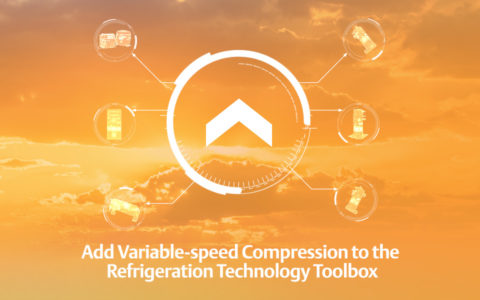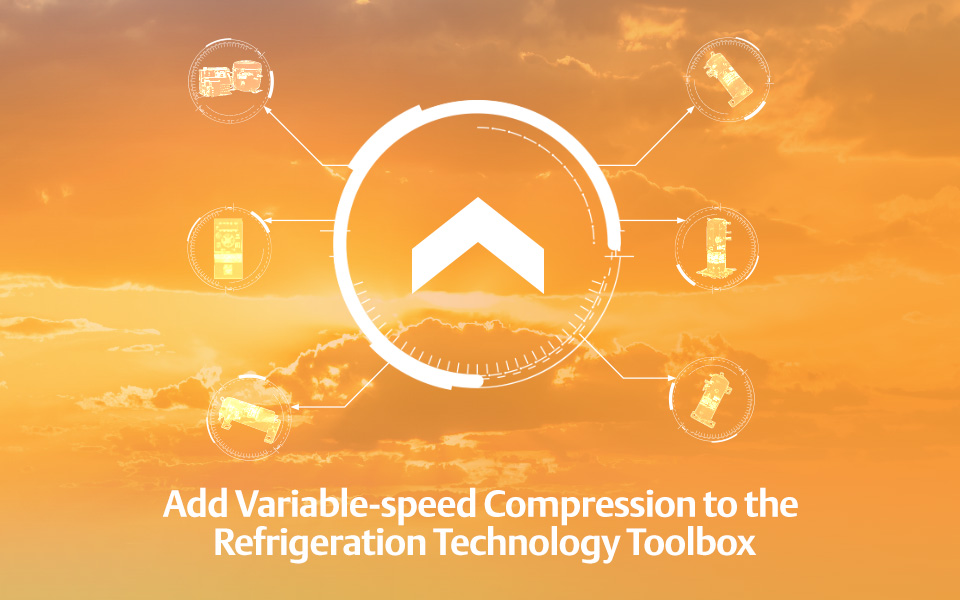Add variable-speed compression to the refrigeration technology toolbox

*On June 1, 2023 Emerson’s Climate Technologies business became a new standalone company – Copeland. Though our name has changed, we are building on more than a century of HVACR innovation and industry leadership, and Copeland continues to offer the same products, industry stewardship, and learning opportunities you’ve grown to trust. Information found on this webpage posted before June 1, 2023 may contain our old name or branding, but you can be at ease knowing it was created with the knowledge and expertise of Copeland.
Among the available options to improve refrigeration efficiency and performance, variable-speed compression technology has historically been an underutilized asset in the system design toolbox. Instead of exploring its many benefits, many supermarket and restaurant retailers continue to hold on to persistent misperceptions about high costs and implementation complexities. Today, shifting market dynamics, technological advances and sustainability concerns are reshaping the conversation. In a recent article for Consulting-Specifying Engineer, I explored the growing business case for variable-speed compression technology across an expanding spectrum of commercial refrigeration applications.

What’s causing the industry to re-examine the potential of variable-speed compression technology? Sustainability initiatives, refrigerant regulations and energy-efficiency mandates are driving food retailers toward more efficient refrigeration equipment. Many are evaluating equipment that will help them to lower their total equivalent warming impact (TEWI) by:
- Delivering high energy efficiencies and/or achieving ENERGY STAR® certification
- Leveraging lower-global warming potential (GWP) refrigerants
At the same time, food retailers are responding to market trends by adopting smaller-format stores that favor distributed refrigeration strategies over traditional centralized architectures. As a result, self-contained, reach-in refrigerators and freezers, display cases and walk-in coolers — that don’t need to be connected to a centralized rack system — are becoming more commonplace while offering increased merchandizing flexibility.
Due to a steady decline in the applied costs of power electronics, manufacturers of variable frequency drives (VFDs) have made tremendous strides in improving their application potential and ease of use. All told, the cost/benefit analysis of variable-speed compression technologies has improved significantly, bringing them into parity with traditional refrigeration options while delivering a variety of end-user benefits, including:
- Improved energy efficiency via better load matching, less cycling on and off, soft start-ups and faster pull-downs
- Increased precision and accuracy of temperature and humidity control
- Enhanced equipment reliability via proactive motor failure prevention, improved diagnostics, reduced start/stops and power fluctuation management
- Accelerated return on investment (ROI) via energy and equipment savings
- Adaptable to multiple applications
- Decreased, more controllable noise levels
- Opportunities to become even more affordable via the availability of state and utility incentives that can greatly reduce upfront costs
How Copeland is supporting OEMs
For original equipment manufacturers (OEMs) of these self-contained systems, variable-speed compression represents one of the few remaining options capable of helping them to improve energy efficiencies or meet market demands for environmentally friendly refrigeration equipment.
Copeland’s variable-speed compression technology consists of a variable-speed compressor — typically a low-profile horizontal or vertical scroll — paired with a VFD. Rather than using a traditional induction motor, compressors are equipped with brushless permanent magnet (BPM) motors to deliver:
- Improved efficiency, even at low speeds
- Increased power density to allow for smaller compressors
- 15 to 30% overall efficiency improvements while reducing size and cost
Pairing a low-profile scroll compressor with a VFD enables it to modulate across a much broader capacity range. Rather than cycling on and off, compressors can precisely match capacity in response to changing refrigeration loads. This paired VFD and compressor approach delivers twice the speed and capacity in a much smaller scroll compressor (e.g., 7,000 revolutions per minute [RPM] versus 3,500 RPM) while delivering:
- Improved equipment reliability
- Continuous and more precise temperature and humidity control
- Low starting torque to eliminate startup current spikes
Copeland™ variable-speed compressor lineup
Copeland horizontal and vertical scroll compressors are seamlessly integrated with Copeland EVM drives to create best-in-class, variable-speed compression solutions for commercial refrigeration.
Variable-speed horizontal scroll compressors
Horizontal scrolls are well-suited for lower-profile, medium-temperature (MT) applications such as stand-alone display cases and self-contained packaged systems.
- ½ to 4 HP capacity modulation range
- Approved for use with R-290 (GWP = 3) and lower-GWP A1 refrigerants (R-448A, R-449A)
- Height is less than 10 inches, providing maximum design flexibility
Per the recent charge increases approved by the UL 60335-2-89 safety standard, Copeland is currently qualifying our horizontal scroll compressors for R-290 charges up to 500g. We are also working to make them A2L-ready when A2Ls are approved for use in commercial refrigeration.
Variable-speed vertical scroll compressors
Traditional vertical scrolls have an expanded capacity range that can cover a wide spectrum of MT and low-temperature (LT) reach-in and walk-in equipment.
- ¼ to 7 HP capacity modulation range
- Approved for use with R-448A and R-449A; currently qualifying A2Ls for future use
- Vapor-injection option available for LT applications
Variable-speed fractional hermetic compressors
Fractional Copeland hermetic compressors are ideal for smaller, MT and LT reach-in units, display cases and walk-ins. Their small profile helps to maximize available merchandizing space.
- ⅛ to ⅞ HP capacity modulation range
- Integrated VFD with smart controller
- Approved for use with R-290
Today, Copeland continues to expand its variable-speed compression solutions to provide end-users and OEMs with an ideal combination of versatility, high performance, reliability and efficiency. To learn more, please explore our variable-speed compression solutions.

8 proven strategies for rigorous cold chain management
by Dan Knauer | Cold Chain
Preparing for the approval and safe use of A2Ls in commercial refrigeration applications...
Protection for high-value shipments just got even better
by Alex Axelsson | Cold Chain, Transportation
We’re excited to announce the release of Copeland’s newest real-time tracker, the GO Real-Time...

Three proven strategies to prevent cargo theft
by Chris Lafferty | Cold Chain, Transportation
The over-the-road (OTR) transport industry is experiencing a surge in cargo thefts. As thieves...
The post Add Variable-speed Compression to the Refrigeration Technology Toolbox appeared first on Copeland.